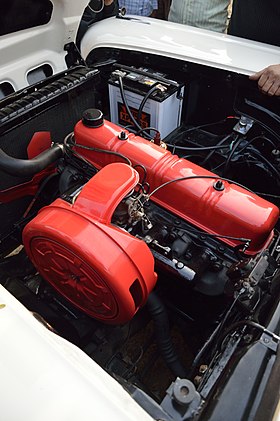Ford Straight-6 engine
| Ford 170 Special | |
|---|---|
 |
|
| Overview | |
| Manufacturer | Ford Motor Company |
| Production | 1941 - 1996 (US) 1960 - 2016 (AUS) 1961 - 1995 (ARG) |
| Combustion chamber | |
| Cylinder block alloy | Cast iron |
| Cylinder head alloy | Cast iron |
| Valvetrain | OHV |
| Combustion | |
| Fuel system | Naturally aspirated or turbocharged, carburated |
| Fuel type | Gasoline |
| Cooling system | Water-cooled |
| Rouge 226/254 | |
|---|---|
| Overview | |
| Production | 1940 - 1953 |
| Combustion chamber | |
| Displacement |
226 cu in (3,700 cc) 254 cu in (4,162 cc) |
| Cylinder bore |
3.30 in (84 mm) - 226 c.i. 3.50 in (89 mm) - 254 c.i. |
| Piston stroke | 4.4 in (112 mm) |
| Output | |
| Power output |
90–95 hp (67–71 kW) - 226 c.i. 115 hp (86 kW) - 254 c.i. |
| Mileage Maker/Cost Clipper | |
|---|---|

The 223 cu in version in a 1959 Ford Fairlane
|
|
| Overview | |
| Production | 1952 - 1964 |
| Combustion chamber | |
| Displacement |
215 cu in (3,523 cc) 223 cu in (3,653 cc) 262 cu in (4,301 cc) |
| Cylinder bore |
3.56 in (90 mm) - 215 c.i. 3.625 in (92 mm) - 223 c.i. 3.718 in (94 mm) - 262 c.i. |
| Piston stroke |
3.6 in (91 mm) - 215/223 c.i. 4.03 in (102 mm) - 262 c.i. |
| Output | |
| Power output |
101 hp (75 kW) - 215 c.i. 115 to 145 hp (86 to 108 kW) - 223 c.i. 152 hp (113 kW) - 262 c.i. |
| 144 Thriftpower Six | |
|---|---|
| Overview | |
| Production | 1960 - 1964 |
| Combustion chamber | |
| Displacement | 144 cu in (2,365 cc) |
| Cylinder bore | 3.5 in (89 mm) |
| Piston stroke | 2.5 in (64 mm) |
| Compression ratio | 8.7:1 |
| Output | |
| Power output | 84 hp (63 kW) at 4200 rpm |
| Torque output | 134 lb·ft (182 N·m) at 2000 rpm |
| 170 Special Six | |
|---|---|
 |
|
| Overview | |
| Production | 1961 - 1972 |
| Combustion chamber | |
| Displacement | 170 cu in (2,781 cc) |
| Cylinder bore | 3.5 in (89 mm) |
| Piston stroke | 2.94 in (75 mm) |
| Compression ratio | 9.1:1 |
| Output | |
| Power output | 105 hp (78 kW) at 4400 rpm |
| Torque output | 156 lb·ft (212 N·m) at 2400 rpm |
| Truck Six | |
|---|---|
| Overview | |
| Production | 1964 - 1996 |
| Combustion chamber | |
| Displacement | 240 cu in (3.9 L) 300 cu in (4.9 L) |
| Cylinder bore | 4" |
| Piston stroke | 3.18" (240) 3.98" (300) |
| Combustion | |
| Fuel system |
Normally aspirated 1BBL Carburator (64-73 240) (64-86 300)Fuel injection (87-96 300) |
| Output | |
| Power output | 114 hp (85 kW) - 150 hp (112 kW) |
| Torque output | 260 lb·ft (353 N·m) |
In 1906-1907, Ford's first straight-6 engine was introduced in the Model K. Henry Ford did not like the car because the engine could overpower its transmission.
The next Ford six was introduced in the 1941 Ford. The Ford Motor Company of America continued producing straight-six engines until 1996, when they were discontinued in favor of more compact V6 designs. Ford Australia manufactures these engines for their Falcon and Ford Territory vehicles.
226 cu in (3,700 cc)
3.30 in (84 mm) - 226 c.i.
90–95 hp (67–71 kW) - 226 c.i.
The first-generation Ford six-cylinder engines were all flatheads. They were the G- and H-series engines of 226 cu in (3.7 L) used in cars and trucks and the M-series of 254 cu in (4.2 L) used in larger Ford trucks and for industrial applications.
Introduced with the 1941 model year, the first Ford L-6 (designated G-series) displaced 226 cu in (3.7 L) and produced 90 hp (67 kW), the same as the Flathead V-8 that year. Like the V-8, it was also a flathead or L-head engine. In 1948, Ford raised the compression of the flathead six or L-6 (designated H-series or Rouge 226) so that it generated 95 hp (71 kW) and 180 lb·ft (244 N·m) of torque. The G- and H-series engines were used in the full-sized Ford cars and trucks to replace the smaller 136 cu in (2.2 L) Flathead V8 that were used with the 1937 Ford. Ford discontinued production of the H-series engine with the 1951 model year.
A 254 cu in (4.2 L) version of the L-6 (designated the M-series or Rouge 254) was used from 1948 to 1953 in F6-series Ford trucks (COE, Dump, semi-, etc.), and small Ford school buses. The M-series engine produced 115 hp (86 kW) and 212 lb·ft (287 N·m). of torque. They were also used in miscellaneous industrial applications. e.g., to power water pumps for irrigation purposes and within wine-producing farms to manage risk by powering giant frost-control propellers on stands in the middle of rows of grapes.
...
Wikipedia
